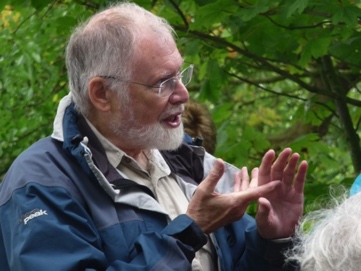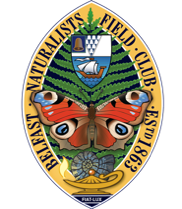

Philip Doughty came from the small mining town of Wombwell in the West Riding of Yorkshire. He went to nearby Barnsley Grammar School, overlapping with Michael Parkinson, then on to Nottingham University where he graduated in Geology and completed a Master’s degree. While writing his Master’s thesis he married Janet and taught at Giggleswick School, Settle, North Yorkshire. His thesis Joint densities in the Great Scar Limestone was eventually published in the Proceedings of the Yorkshire Geological Society.
His first museum job was as a general natural history curator at Scunthorpe Museum. Then in 1965 he became an Assistant Keeper in the Natural History department of the Ulster Museum. Phil always stressed that he was appointed as a geologist to care for and develop the geology collections – a specialist geologist on the staff for the first time in the Museum’s long and complicated history, dating right back to the opening of the Belfast Natural History & Philosophical Society’s Museum in 1831. This was an exciting time to join the fledgling Ulster Museum – with its recent elevation from local authority to national status, its growing staff numbers and a large new extension to the existing building being planned.
In 1970 he became Keeper of his own new Department of Geology. Against a generally favourable background of Museum expansion, over the next few years he built up a small team of geologists: Terry Bruton, John Wilson, Rab Nawaz and Ken James. His top priority was rescuing the stored geology collections from where they had languished since World War Two – at the bottom of a lift shaft in the Museum and in rat-infested lock-ups beneath the railway bridge on Tate’s Avenue, Belfast.
Phil and his team were responsible for creating a series of innovative and award-winning geology galleries which opened sequentially through the 1970s – Variety of Life, Geology of Ireland, Landscape and Earth’s Treasures – the success of these galleries followed from the detailed briefs Phil had prepared. It is a testament to their effectiveness that, with only relatively minor changes, they remained popular with visitors for some three decades.
The geology collections were built up by astute purchases of display material and by systematic field collecting. Phil also knew that good research projects helped to boost the Museum’s credibility - projects such as the Bovedy meteorite in 1969, the 1972 Pollnagollum cave excavations in Fermanagh, and the 1986 Aghnadarragh mammoth discoveries near the Antrim shore of Lough Neagh. It’s telling that both the Polnagollum and Aghnadarragh projects arose from chance discoveries made by members of the public who knew that the place to find out more would be Phil’s Geology Department at the Ulster Museum.
His personal mission, to raise the profile of geology, geology collections and museums generally, took him beyond Northern Ireland. He was a prominent member of the UK-wide Museum Assistants Group, editing their newsletter, and he helped to found the Geological Curators’ Group (GCG) in 1974 - the first of the subject specialist groups that have done so much to raise curatorial standards generally. He organised a ground-breaking survey of museums for GCG, published in 1981 as The State and Status of Geology in UK Museums. This helped to change attitudes towards long-neglected geology collections across the country. He chaired GCG in the mid-1980s and was quite recently awarded the group’s prestigious Brighton Medal for outstanding services to museum geology.
While a Council member of the UK Museums Association, he became involved with their Information Retrieval Group and helped to pioneer new methods of managing information about museum objects. This put the Ulster Museum in at the start of the digital revolution in museum data handling, during the late 1970s and 80s.
But Phil knew better than many that there’s no point in having well-organised and well-documented museums if you don’t get out there and communicate the excitement and relevance of collections to the public. He was a great communicator, with an ability to inspire his audience. From answering enquiries one-to-one, to the many extra-mural classes he taught for Queen’s University Belfast in the 1970s and 80s, and establishing the Geology Tamed! lecture series at the Ulster Museum in 2002, his ability to grab and hold people’s attention was clear. That same talent was just as evident in the field, of course, when leading field trips for the Belfast Geologists’ Society, or the Belfast Naturalists’ Field Club, or the annual Rocks Around the North week. This ability to get the message across extended to his many radio and TV broadcasts, and to the written word – from articles in the popular press to the formality of site conservation reports – most famously perhaps, his words to UNESCO which helped bring World Heritage Site status to the Giant’s Causeway in 1986.
Phil also knew that to effectively engage with an audience, you needed to put on a good show! The legendary Moon Rock display in 1970 attracted 27,000 people to the Museum in a single day – that has never been beaten. The Dinosaurs Alive! exhibition in 1992 brought giant, robotic dinosaurs to Ireland for the first time – attracting 200,000 paying visitors to the Ulster Museum in three months, which is another record.
His love of fieldwork, and its centrality to both the current practice and historical development of geology, meant that site conservation and interpretation were constant threads running through his career. At the site level he helped with the development of Marble Arch Caves by Fermanagh District Council and he was writing text for the National Trust about the Giant’s Causeway as long ago as 1969. At a national level, he was a founder and chairman of the Geological Society’s GeoConservation Committee. And in his retirement, he wrote hundreds of ‘plain-language’ site summaries for NIEA’s Earth Science Conservation Review – all of which are available on the web (www.habitas.org.uk/escr).
Phil was a fine all-round scientist, with a holistic understanding of the natural world. From the early 1990s, by then Head of the Museum’s re-organised Sciences Division, he worked with colleagues in the Museum and at the Department of the Environment to nurture an infant environmental records centre that eventually became today’s Centre for Environmental Data and Recording. In the late 90s he was a key member of the Northern Ireland Biodiversity Group, which in 2002 produced the national Biodiversity Strategy that informs the country’s wildlife policy to this day.
So, his professional legacy is clear – he worked and lobbied hard and successfully to improve standards of collections care and interpretation, information management, public engagement, site conservation and recording, and the development of public policy in all these areas.
He also consistently supported the work of local and regional voluntary groups, such as the Belfast Geologists’ Society, the Belfast Naturalists’ Field Club and Earth Science 2000 (ES2k, now Earth Science Ireland) – all three of which he led as president or chairman at different times, and served on their general committees for long periods.
But I suspect that Phil would have judged his most important legacy to be all those countless individual sparks of interest which his infectious enthusiasm fanned into flame. For the youngster with a puzzling fossil to be identified, he could vividly bring to life a long-extinct creature from a strange and ancient world – for many, such an experience would open the door to a life-long interest in geology. What better epitaph could there be than that?
Peter Crowther
Phillip Doughty (5th March 1937-14th January 2013)


